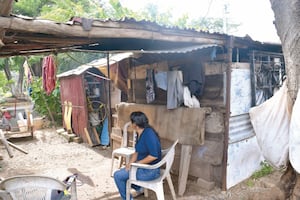Más Información

"Queremos cerrar este capítulo", dice Salinas Pliego al SAT; esperarán a enero a conocer fundamentos legales de adeudo fiscal
Mundial 2026 genera riesgo de fraudes y reventa, alerta Concanaco; sugiere desconfiar de enlaces y ofertas en redes sociales

Marco Rubio destaca labor de seguridad de México; "están haciendo más que nunca en su historia", afirma

Inegi oficializa creación de nueva instancia para medir la pobreza, tras desaparición del Coneval; crea una Dirección General

Juez frena revocación de testigo protegido a Raúl Rocha; da medida cautelar a dueño de Miss Universo
Young Mexican Nathalie Vilchis, who is 21 years old and studies Mechatronics Engineering at the Monterrey Institute of Technology and Higher Studies (ITESM), was selected to be part of a research stay at the NASA’s Jet Propulsion Laboratory, nevertheless, she is looking for help to make her dream come true.
“The project they assigned me is a plasma drill that pierces through ice layers at cryogenic temperatures aimed for the Mars poles and the frozen satellites in Jupiter and Saturn. This is in order to obtain samples and help look for life in other planets,” says the young woman in a video.
Through her social networks and a fundraising platform, one of the three Mexican selected to be part of this initiative is looking to raise MXN $240,000 to be able to attend the program.
“By winning this call, and according to NASA’s rules, funding for this trip cannot come from the participant’s personal or family funds. They must come from companies, universities, foundations, or third parties,” as mentioned by the call published on a crowdfunding site.
Recommended:
Her stay will last for five months and she needs USD $2,400 per month, the reason why she established the previously mentioned amount.
For two years in a row, Natalie Vilchis has won the first place at NASA’s Air and Space Program and is part of the Astronomy Society of the ITESM, where she helps disseminate space science.
The Mechatronics student, along with the Metropolitan University of Tokyo, has participated in projects such as the development of a space robotic arm, gyroscopes, and autonomous landing systems.
In an interview with EL UNIVERSAL, Vilchis said that one of the reasons why she thought going to space was quite complicated was because of the obstacles faced in Mexico, although she has now changed her mind.
The Nuevo León student remembers that it was in high school when she first had the opportunity to approach a NASA program and was able to meet the people who work there.

“I noticed I was also able to get there. There were women , there were latinos, there were staff members who looked like me and that was when I decided I wanted to be that,” she says about the moment her mind changed regarding the possibilities for her personal development.
Despite her academic performance and wish to go to space, the Young student faced a challenge when the time came to start her professional studies for two years ago, the National Autonomous University of Mexico (UNAM) still did not offer Aerospace Engineering, which was just created last February.
That is why Natalie Vilchis tried to study abroad but despite being accepted and the scholarships she was granted, she could not attend because it was still too expensive .
Nevertheless, she took the opportunity to study at the Tec de Monterrey and chose to study mechatronics due to her passion for robotics, which she focused on the development of space technology.

Nathalie has obtained financing from Mexican politicians, the Banorte foundation, and women’s groups.
Nathalie says she has never felt limited in her education because of being a woman because she grew up watching her mom, who is a Chemical engineer.
“I saw her studying engineering so I never had the idea of not being able to do it,” said Vilchis and added that it was just until she began her major that she noticed there were very few women compared to men.
“Speaking of my female schoolmates, they told me they were afraid because engineering was a men’s career. I noticed that the world and girls who are about to choose their major need to see what I had, a model of a woman who studied engineering and had no problems because of that, or that if she did, she found ways to overcome them.”
Surprised by the support she has received for over eight months, what the Mexican student is most excited about is that people that do not know her believe in her, “when there’s this kind of support, you can always carry on.”
“I’m very excited, I’d love to participate in the development of technology that is sent to Mars or a farther point. I’d love to think that if I work in this project, I can go to Mars or some of Jupiter’s or Saturn’s satellites,” says Nathalie Vilchis, who is almost 40 days from concluding her crowdfunding campaign.

NASA’s Jet Propulsion Laboratory
According to NASA, the Jet Propulsion Laboratory is a research facility managed by Caltech that carries out robotic space and Earth science missions.
In addition to its missions, JPL developed and manages NASA's Deep Space Network, a worldwide system of antennas that communicates with interplanetary spacecraft.
Recommended:
The JPL implements programs in planetary exploration, Earth science, space-based astronomy, and technology development. Moreover, JPL technology developed to enable new missions is also applied on Earth to benefit our everyday lives.
mp
Noticias según tus intereses
[Publicidad]
[Publicidad]









